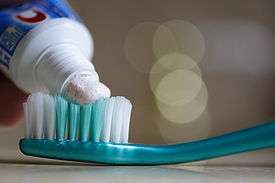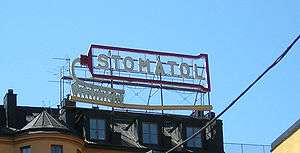List of toothpaste brands

Toothpaste from a tube being applied to a toothbrush
Toothpaste is a gel dentifrice used in conjunction with a toothbrush to help clean and maintain the aesthetics and health of teeth. Toothpaste is used to promote oral hygiene; it functions as an abrasive agent that helps to remove dental plaque and food from the teeth, works to suppress halitosis, and delivers active ingredients such as fluoride or xylitol to the teeth and gums to help prevent tooth decay (cavity) and gum disease (gingivitis).[1]
This list includes notable brands of toothpaste, both historic and contemporary.
Toothpastes

A 1949 Chlorodont advertisement, published in Germany's Voice (a New York publication)
- Aim: a brand of toothpaste from Church and Dwight. Aim was introduced in 1973 by Unilever, and the brand was purchased by Church and Dwight in 2003.[2]
- Aquafresh: available since 1979, it is manufactured by consumer healthcare product maker GlaxoSmithKline.[3]
- Arm & Hammer: Some versions include baking soda in the product.
- Babool: launched in by Balsara Hygiene in 1987,[4] Babool is made from the bark of the Babool tree, which has traditionally been used to clean teeth in India.[5]
- Binaca: an oral hygiene brand that is marketed in India and owned by Dabur.[6]
- Burst: Launched in 2018 by oral hygiene brand Burst Oral Care.
- Chlorodont – a toothpaste advertised to German Americans in New York City in 1949
- Close-Up: marketed by Unilever,[7] it was launched in 1967 and was the first gel toothpaste in the world.[8]
- Colgate: marketed by Colgate-Palmolive, it is the first toothpaste in a collapsible tube, introduced in 1896, after having been sold in glass jars since 1873.[9]
- Crest: a Procter & Gamble product. At first it used stannous fluoride, marketed as "Fluoristan" (this was also the original brand name it was sold under—it was later changed from "Fluoristan" to "Crest with Fluoristan").
- Dabur: first introduced in India by Dr. S.K. Burman in 1884.
- Darlie: first manufactured in Shanghai in 1933 and later based in Hong Kong and Taiwan, Hawley & Hazel was acquired in 1985 by the United States corporation Colgate-Palmolive, although the product is not marketed by Colgate-Palmolive.[10]
- Doramad Radioactive Toothpaste: produced from 1940 to 1945 in Germany by Auergesellschaft of Berlin, it contained small amounts of thorium, although later analysis showed its radioactivity levels to be very low.[11]
- Dr. Lyon's Tooth Powder: a brand of powdered dentifrice mainly popular during the mid twentieth century. It is still available today in independent drug stores and certain drug store chains. Purportedly created by Dr. J. W. Lyons D.D.S.[12]
- Elmex:[13] sold since 1962, it is manufactured by GABA International AG, a Swiss manufacturer of branded oral care products.
- Euthymol: a brand of antiseptic, fluoride-free toothpaste distributed by Johnson & Johnson that is characterised by its bright pink colour and medicinal taste. The antiseptic ingredient in the product is thymol.
- Gleem:[14] a brand of toothpaste made by the Procter & Gamble company.
- Ipana[15] a popular toothpaste during the 20th century, first introduced in 1901 by Bristol-Myers of New York. The brand is now owned by Maxill Inc. of Canada. The famous Disney-created mascot named Bucky Beaver joined the Ipana marketing efforts in the 1950s.
- Kalodont: discontinued in 1981,[16] it was originally produced by F. A. Sarg’s Sohn & Co. from Vienna and first sold in Austria-Hungary in 1887. It later became widely distributed, in 34 other countries, and obtained a near-monopoly status that caused the word "kalodont" to become synonymous with the word for "tooth paste" in South Slavic languages. It was also available in Russia in 1927.[17]
- Macleans: a brand of toothpaste by GlaxoSmithKline, available in the US until the early 1980s, now marketed in Australia and New Zealand.
- Kolynos as the name of an old-time line of oral care products that was created by Newell Sill Jenkins in 1908 and acquired by Colgate-Palmolive in 1995.Although not now readily available in the US, the brand remains strong in Latin America, and also manufactured in Hungary. In Brazil, for instance, Kolynos was the second best-selling brand, after Colgate itself.
- Marvis: a brand of toothpaste, originally from Florence, Italy[18]
- Mentadent: a brand name for a line of dental products manufactured by Unilever everywhere but United States and Canada, where it was acquired by the Church & Dwight Company in 2003.
- Mentadent SR[19] formerly named "Gibbs SR", is a brand of toothpaste owned by Unilever.
- Meswak:[20] launched in India by Balsara Hygiene in 1998,[20] it is marketed as a herbal toothpaste.[21] It is prepared from extracts of the Salvadora persica plant.[22]
- Oral-B: a brand of the Procter & Gamble company
- Parodontax
- Pepsodent: a brand of toothpaste with a minty flavour derived from sassafras. It was advertised for its purported properties fighting tooth decay, attributed in advertisements to the supposed ingredient Irium. Irium is another word for sodium lauryl sulfate, an inexpensive ionic surfactant.[23] It was first introduced in the USA in 1915 by the Pepsodent Company of Chicago, later purchased by Unilever in 1944.
- Promise:[20] launched by Balsara hygiene in 1978 in India, the brand's tagline was "The unique toothpaste with time-tested clove oil."[24]

Rembrandt Intense Stain toothpaste
- Rembrandt toothpaste: a brand of toothpaste that has built its brand on the promise of whitening
- Sensodyne: a brand of toothpaste by GlaxoSmithKline, marketed for people with sensitive teeth[25] and/or dentine hypersensitivity.
- Signal: a brand of toothpaste produced by the Unilever company. Signal is also known as Pepsodent (Asia & Latin America), Mentadent (Italy), Zhong Hua (China), Aim (Greece), Prodent (Netherlands) and P/S (Vietnam).[26]
- Sozodont:[27] a popular brand of oral hygiene product from the mid-nineteenth century to the early twentieth century. According to an 1889 issue of the journal American Druggist, Sozodont was made from a liquid and powder mixture. The powder contained orris root, carbonate of calcium, and magnesia. The liquid contained castile soap (soap made exclusively from vegetable oil), glycerin, sizable portions of water and alcohol, and, for flavoring, a small quantity of oil of peppermint, clover, cinnamon, and star anise, as well as, for coloring, cochineal (a dye made from an insect of the same name).[28]
- Stomatol: first sold in Sweden at the beginning of the 20th century, it was particularly notable as having been one of the first Swedish brands to recognize and to use the power of mass media.
- Tom's of Maine: founded by Tom and Kate Chappell in 1970 with US$5,000. In 2006, a controlling 84% stake in Tom's of Maine was purchased by Colgate-Palmolive for US$100 million.[29] The Chappells own the remaining sixteen percent.
- Ultra Brite:[30] an American toothpaste and tooth-whitener marketed by Colgate-Palmolive in the United States.
- Zendium: a brand of toothpaste made by Unilever and marketed in the Netherlands, Belgium, Germany and Scandinavia for some years, with its expansion into the French and Italian markets in 2015.
See also
References
- ↑ American Dental Association Description of Toothpaste"Toothpaste". April 15, 2010.
- ↑ Associated Press (August 20, 2012). "Church & Dwight to buy Avid Health for $650M". Bloomberg Businessweek. Retrieved September 5, 2012.
- ↑ "Aquafresh: How a leading global brand has earned its stripes" (PDF). Business 2000. The Irish Times. Retrieved May 26, 2011.
- ↑ All India Management Association (1989). Indian Management. 28: 23. Missing or empty
|title=(help) - ↑ "Balsara to revamp toothpaste portfolio". The Hindu Business Line. August 6, 2002. Retrieved March 13, 2012.
- ↑ "From household names to forgotten history: Story of India's grand old brands such as Binaca, Dalda & Moti Soaps". The Economic Times. November 28, 2011. Retrieved March 13, 2012.
- ↑ "Colgate and Unilever battle in India with the same smile". The Financial Express. April 21, 1999. Retrieved March 13, 2012.
- ↑ "A unique oral care brand for up-close situations". Unileverme.com. Archived from the original on February 24, 2012. Retrieved March 13, 2012.
- ↑ Colgate-Palmolive Company History | Creating Bright Smiles for 200 Years | Colgate.com
- ↑ Fish, Isaac Stone (November 30, 2010). "Back to the Days of Blackface". Newsweek. Retrieved September 5, 2012.
- ↑ "Doramad Radioactive Toothpaste". Retrieved October 1, 2011.
Doramad radioactive toothpaste was produced during World War II by Auergesellschaft of Berlin.
- ↑ "Famous Tooth Powder Bossy Product". Retrieved November 11, 2016.
- ↑ "Gaba International". Gaba International. Retrieved September 5, 2012.
- ↑ "Advertising & Marketing", The New York Times, November 21, 1952, Page 36.
- ↑ "It's the new ipana". Maxill Inc. Retrieved December 22, 2013.
- ↑ "Zubne paste – kozmetika i higijena". Poslovni dnevnik (in Croatian). January 20, 2011. Retrieved September 4, 2011.
- ↑ Kiaer, Christina; Naiman, Eric (2006). Everyday life in early Soviet Russia: taking the Revolution inside. Indiana University Press. p. 148. ISBN 978-0-253-21792-9. Retrieved September 4, 2011.
- ↑ Tien, Ellen (March 3, 2002). "La Dolce Vita In Every Smile". Pulse: P.S. The New York Times. Retrieved July 13, 2012.
- ↑ "The end of a golden age". Marketing Week. January 6, 2005. Retrieved September 5, 2012.
- 1 2 3 "How Balsara Lost Its Bite". Business Standard. August 6, 2002. Retrieved March 13, 2012.
- ↑ Deborah J. Macinnis, Pinaki Dasgupta, Wayne D. Hoyer (2008). Consumer Behaviour. Dreamtech Press. p. 105. ISBN 978-8177227543.
- ↑ "The natural barrier". The Indian Express. February 3, 2008. Archived from the original on December 4, 2008. Retrieved March 13, 2012.
- ↑ Susan Budavari, Maryadele J. O'Neil, Ann Smith, Patricia E. Heckelman, Joanne F. Kinneary. 1996. The Merck Index, twelfth edition. Merk & Co., Inc.: White house Station, NJ. Page 1478
- ↑ Majumdar, Ramanuj (2004). Product Management in India. PHI Learning Pvt. Ltd. p. 76. ISBN 978-8120312524.
- ↑ Lesch, William C.; David Rupert (1994). New Product Screening. Haworth Press. p. 79. ISBN 978-1-56024-404-2. Retrieved September 29, 2008.
- ↑ http://www.unilever.com/brands-in-action/detail/Signal/292111/ Unilever Signal Brand website
- ↑ Roswell Van Buskirk obituary, American Druggist and Pharmaceutical Record (1902).
- ↑ "Questions & Answers: Sozodont". American Druggist. July 1889. Retrieved July 17, 2007.
- ↑ "Colgate expands reach of quirky toothpaste". USATODAY.com. Gannett Co. Inc. The Associated Press. March 22, 2006. Retrieved July 28, 2011.
- ↑ Marconi, Joe (1999). The Brand Marketing Book. McGraw-Hill Professional. pp. 108–9. ISBN 978-0-8442-2257-8.
External links


This article is issued from
Wikipedia.
The text is licensed under Creative Commons - Attribution - Sharealike.
Additional terms may apply for the media files.
